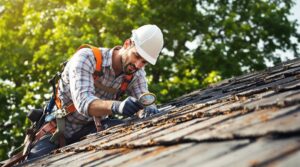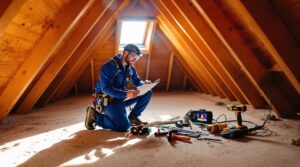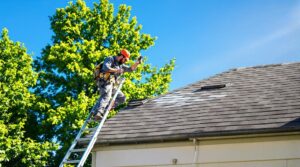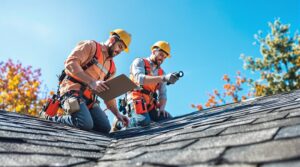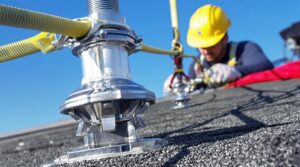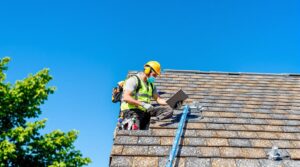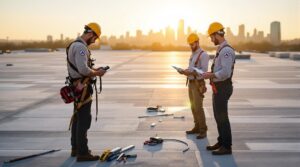Ever wondered how modern technology is revolutionizing the way we check our roofs? Drone inspections are like having a high-tech guardian angel watching over your property from above!
Think of these smart flying cameras as your personal roof detectives, soaring safely above while capturing every nook and cranny in stunning detail. They're equipped with eagle-eye cameras and thermal sensors that can spot issues your naked eye might miss – from sneaky leaks to hidden structural problems.
What's really cool is that these aerial helpers create detailed 3D models of your roof, giving you a crystal-clear picture of its condition without anyone having to climb up there. It's like getting an X-ray of your roof's health, but way more comprehensive!
Licensed drone pilots follow carefully planned flight patterns, kind of like connecting invisible dots in the sky, to ensure they don't miss a single shingle. They're pros who know all the rules and regulations – because let's face it, nobody wants a rogue drone buzzing around their neighborhood!
Ready to step into the future of property inspections? These flying tech wizards are transforming what used to be a dangerous, time-consuming task into a safe, efficient, and incredibly accurate process. Your roof deserves this level of attention, don't you think?
Key Takeaways
Ever wondered how modern roofers are taking inspections to new heights? Welcome to the game-changing world of drone roof inspections!
Think of these smart flying cameras as your roof's personal health scanner. They're like having a skilled inspector with superhuman abilities – soaring above your property with crystal-clear vision and thermal superpowers, all while keeping their feet firmly on the ground.
Before you launch your drone inspection business, though, you'll need to check some important boxes. The FAA's Part 107 certification isn't just paperwork – it's your golden ticket to legal commercial drone operations. Don't forget insurance coverage and local permits, they're your safety net in this high-flying venture.
Your drone toolkit should pack a punch: a sharp-eyed camera (12MP minimum), thermal imaging for those sneaky hidden issues, and rock-solid GPS tracking. It's like giving your inspection drone a Swiss Army knife of capabilities!
When it's showtime, success lies in the details. Map your flight path, capture systematic aerial shots, and let smart software like DroneDeploy turn your data into gold. The real magic happens when you analyze those findings – spotting issues that could've taken days to find manually.
Why are property owners falling in love with drone inspections? They're lightning-fast, wallet-friendly, and keep everyone's safety in check. Plus, you'll get detailed digital documentation that insurance companies and maintenance teams actually get excited about. Who knew roof inspections could be this revolutionary?
What Are Drone Roof Inspections and Why They Matter
As the construction and maintenance industries continue to embrace technological innovation, drone roof inspections have emerged as a transformative method for evaluating roof conditions. This advanced approach utilizes unmanned aerial vehicles equipped with high-resolution cameras and sensors to assess roofs without physical access.
Drone technology has revolutionized roof maintenance by offering multiple advantages over traditional inspection methods. The system provides enhanced safety by eliminating the need for manual roof access, while delivering superior accuracy through detailed imaging capabilities.
These inspections can capture extensive data, including thermal imaging and 3D modeling, offering unprecedented insight into roof conditions. The efficiency of drone-based assessments translates to reduced costs and faster completion times, making it an increasingly essential tool for property managers, contractors, and insurance professionals. The ability to easily document weather impact assessments through aerial footage has significantly improved the insurance claims process for roof damage.
The Process: Planning and Executing a Drone Roof Inspection
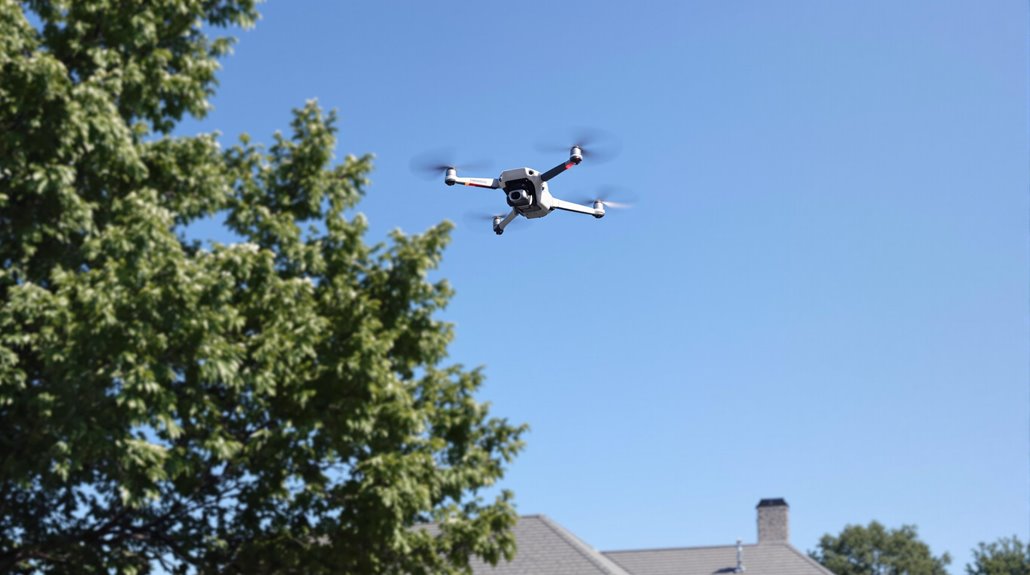
A successful drone roof inspection requires meticulous planning and systematic execution across multiple phases. The process begins with a thorough pre-inspection checklist, including site assessment, weather monitoring, and equipment verification.
Flight safety protocols demand a complete evaluation of potential obstacles and compliance with local regulations.
During execution, operators must follow predetermined flight paths while maintaining proper image overlap for total coverage. The drone's high-resolution cameras and thermal imaging capabilities capture detailed data of critical areas, including roof valleys, vents, and potential damage points.
Post-inspection analysis involves processing captured data into orthomosaic maps or 3D models, enabling detailed assessment of the roof's condition.
The final phase culminates in a thorough report documenting findings, measurements, and specific recommendations for necessary repairs or maintenance.
Benefits and Advantages of Using Drones for Roof Assessment
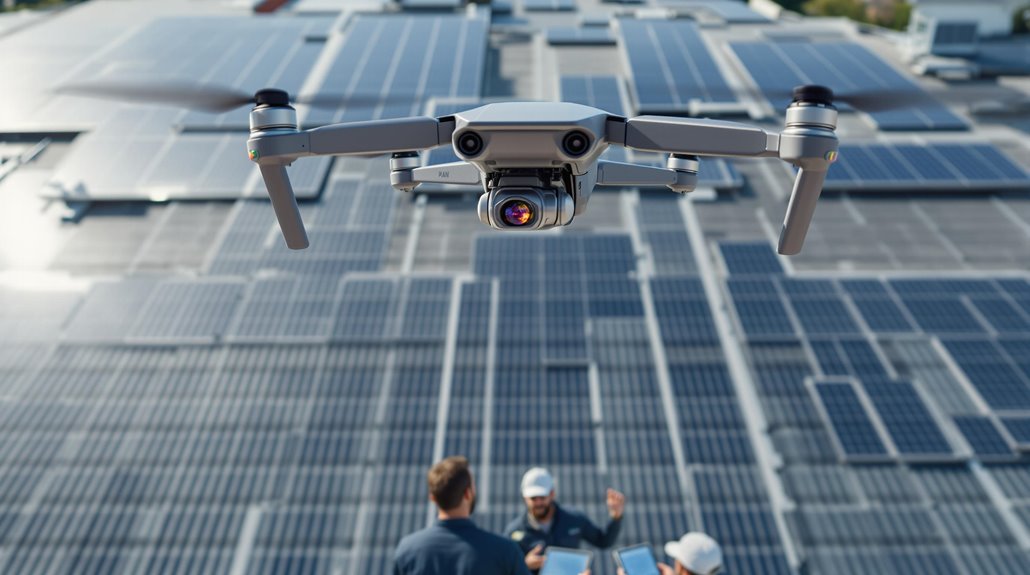
While traditional roof inspections pose numerous challenges and risks, drone technology has revolutionized the assessment process by offering substantial advantages in efficiency, safety, and data quality.
Drones enable rapid data collection through high-resolution imaging and advanced sensing technologies, notably reducing inspection time while enhancing accuracy. The implementation of drone inspections yields considerable cost savings by eliminating the need for specialized equipment and reducing labor requirements.
Safety improvements are paramount, as drone operations conducted from ground level eliminate the risks associated with working at heights. Additionally, drone technology facilitates thorough coverage of difficult-to-access areas and enables real-time data analysis, allowing for prompt identification of potential issues and more informed decision-making in roof maintenance and repairs.
Essential Technology and Equipment for Aerial Roof Inspections
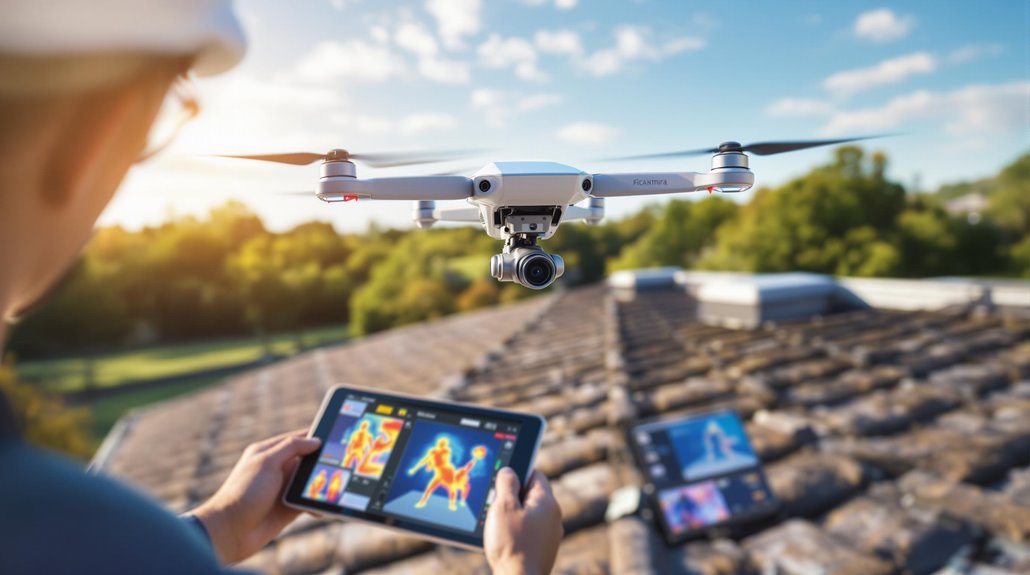
Successful drone-based roof inspections require specific technological components and equipment tailored to the demands of aerial assessment.
Key drone specifications include high-resolution cameras with at least 12 megapixels and 4K video capabilities, along with thermal imaging sensors for detecting hidden issues.
Advanced inspection technology such as GPS, RTK positioning, and obstacle avoidance systems guarantee precise flight control and safety during operations.
Industry-leading models like the DJI Phantom 4 RTK and Mavic 3E/T offer centimeter-level precision, while specialized software platforms such as DroneDeploy and Pix4D enable thorough data analysis.
Essential operational features include sufficient flight time, wind resistance up to 12 m/s, and robust data security measures.
These technological components work together to deliver accurate, detailed roof assessments while maintaining operational safety and efficiency.
Professional Opportunities in the Drone Inspection Industry
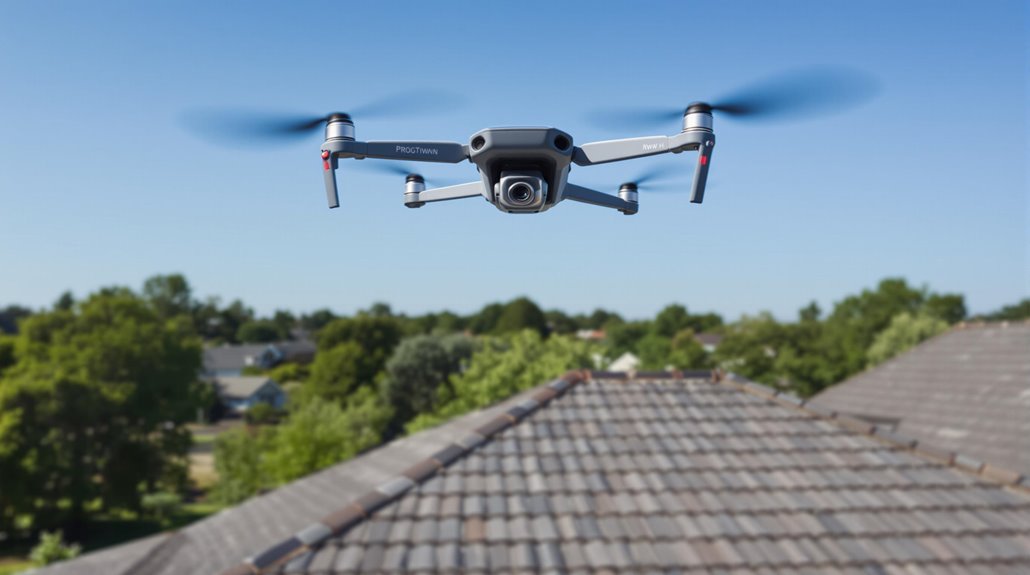
Professional opportunities in the drone inspection industry continue to expand rapidly across multiple sectors, driven by increasing demand for efficient and cost-effective inspection solutions.
Emerging trends indicate significant growth potential in specialized areas such as roof assessments, industrial equipment monitoring, construction site surveillance, and power line inspections.
Advanced drone inspection services are revolutionizing key industries, from rooftop surveys to critical infrastructure monitoring and construction oversight.
The current job market demands both technical proficiency and regulatory compliance. Successful drone inspection professionals must obtain FAA Part 107 certification and maintain expertise in equipment operation and data processing.
Career advancement opportunities exist through specialization in high-value services like thermography or by establishing independent drone inspection businesses.
While initial investment in quality equipment is necessary, the industry offers substantial earnings potential, particularly in industrial and commercial sectors where premium rates are standard for specialized inspection services.
About The Public Claims Adjusters Network (PCAN)
The Public Claims Adjusters Network (PCAN) represents a nationwide coalition of licensed professionals who advocate for policyholders during insurance claim processes.
Operating across all 50 states with international offices, PCAN members specialize in property damage assessment, policy interpretation, and claims advocacy services.
These public adjusters manage complex documentation, provide accurate cost estimates, and negotiate with insurance companies on behalf of businesses and individuals.
Their expertise guarantees fair settlements through thorough policy analysis and effective communication with all involved parties.
PCAN members maintain strict adherence to state-specific regulations and fee structures while utilizing advanced claims management technology.
The organization emphasizes professional development through partnerships with industry associations like NAPIA, guaranteeing high ethical standards and technical competence in claims handling.
Members must have 4+ star reviews and maintain a spotless record with no Department of Insurance complaints within the past 12 months to join the network.
Frequently Asked Questions
How Long Does a Typical Drone Roof Inspection Take to Complete?
Utilizing drone technology, a complete roof inspection typically requires less than 90 minutes total, with preparation taking under an hour and the actual inspection flight lasting 10-30 minutes, demonstrating significant inspection benefits.
What Weather Conditions Are Unsuitable for Conducting Drone Roof Inspections?
Like delicate birds grounded by nature's fury, drones must avoid high winds exceeding 15mph, heavy rain, dense fog, extreme temperatures, and severe weather conditions that compromise flight stability and data collection.
Do I Need Permission From Neighbors for Drone Inspections?
Drone regulations typically require obtaining neighbor consent when flight paths cross adjacent properties. Written permission is recommended to guarantee compliance with privacy laws and prevent potential legal disputes.
How Often Should I Schedule Drone Roof Inspections?
Standard frequency recommendations suggest biannual inspections, with additional assessments after severe weather events. Aging roofs may require quarterly inspections to maximize maintenance benefits and prevent deterioration.
What's the Average Cost Range for a Professional Drone Roof Inspection?
Professional drone technology inspections typically range from $150 to $450, with infrared capabilities increasing costs to $400-$600. Inspection benefits include extensive data collection and reduced physical access requirements.
References
- https://www.eagleview.com/insurance/drone-roof-inspection-for-insurance-a-full-guide/
- https://www.dronepilotgroundschool.com/drone-roof-inspections/
- https://advexure.com/blogs/news/drones-for-roof-inspections-safer-quicker-and-smarter
- https://wini.com/articles/everything-you-need-to-know-about-drone-roof-inspections/
- https://www.dslrpros.com/pages/uses/roof-inspection-drones
- https://strongholdroofing.com/blog/drone-roof-inspections/
- https://forum.dronedeploy.com/t/drone-roof-inspections-what-you-need-to-know/8932
- https://dronelaunchacademy.com/resources/drones-and-roof-inspections-ultimate-guide/
- https://www.bluefalconaerial.com/drone-roof-inspection/
- https://benchmarkroofreports.com.au/blog/roof-inspection-by-drone/
